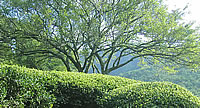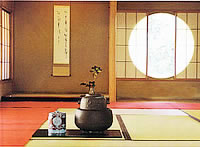
Many researches have been conducted to discover the origin of Japanese green tea, but no definite conclusion has been drawn yet. The widely accepted assumption is that green tea was brought to Japan along with other Asian continental cultures such as rice farming.
During Jomon and Yayoi periods, rice farming spread from the West of Japan to around Shizuoka prefecture. This distribution of rice farming is very much alike to that of green tea.
A strong relationship exists between Japanese tea culture and Buddhism. It is historically known that mission boats to the Continent of Asia had brought back teas to Japan. In Heian period, prominent Buddhists such as Saicho and Kukai went over to the Continent of Asia and brought back, amongst an abundance of new knowledge, teas and Buddhism.
It is believed that Japanese tea culture, as it is known today, was established in Sengoku period. Japanese green tea is unique in its production process which includes steaming and roasting.
The Way of Tea was gradually perfected by the three tea masters, Jukou Murata (1422-1501), Jouoh Takeno (1502-1555), and Senno Rikyu (1522-1591). The tea masters reproved selfishness and egoism and established the mental aspects of the Way of Tea without the two qualities. Murata and Takeno added mentality and aesthetics to the Way of Tea and created "So-an-cha no Yu" and "Wabi-Chado".

Today's Japanese tea culture would not exist without the works of the three tea masters.